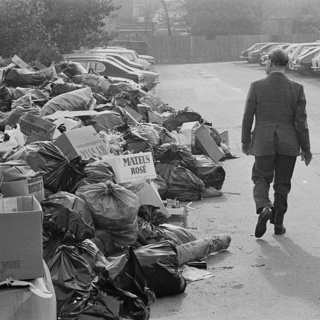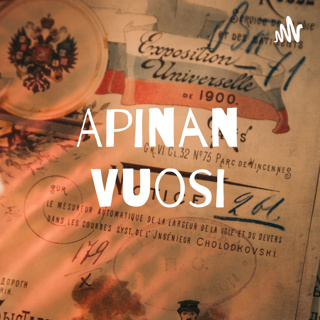
182. Spiral into violence
We’ve reached a time of rising violence in English history. This episode concentrates firstly, and briefly, on the violence around the growing militancy of the trade union movement, worrying and ugly though not even remotely comparable to what was happening in the US at the time – these things are all relative… Next we return to the women’s suffrage movement, to the growing divergence between the Suffragists of Millicent Fawcett’s National Union of Women’s Suffrage Societies and the Suffragettes of Emmeline Pankhurst’s Women’s Social and Political Union, as the former stuck to the commitment to campaigning by legal means only and the latter moved increasingly towards violent actions. But the changes were also producing internal splits within the WSPU itself. We talk in this episode about what happened as the Pankhursts fell out with each other, leading to Adela Pankhurst’s departure to Australia and Sylvia’s expulsion from the WSPU, with her organisation emerging as the East London Federation of Suffragettes, wedded as firmly as ever to the cause of the working class and the Labour Party, and close to one of that party’s most fervent supporters of votes for women, George Lansbury. Finally, we mention the one martyr’s death for the Suffragette cause, that of Emily Davison, an iconic event in the campaign, though perhaps not quite what many people believe it to have been. Illustration: The funeral procession for Emily Davison. Postcar print by Ferdinand Louis Kehrhahn & Co, June 1913. National Portrait Gallery x45196 Music: Bach Partita #2c by J Bu licensed under an Attribution-NonCommercial-No Derivatives (aka Music Sharing) 3.0 International License.
18 Helmi 202414min

181. Ireland: deeper splits, more ugliness
The general elections of 1910 left Asquith’s Liberal government dependent, to stay in office, on the votes of the Irish Nationalist MPs. The price of their support was a renewed attempt to drive through Home Rule for Ireland. That would recreate the Dublin parliament absorbed into Westminster over a century earlier. Gladstone had twice tried to introduce Home Rule but it had split the Liberals. The party then left it on the back burner. Now it was back on the front burner. The problem was that there was powerful opposition to Home Rule, in Britain, but also in Ireland, where Protestant opponents, especially in Ulster, went so far as to raise an armed force to resist it. That meant that Britain might find itself in the paradoxical position of having to use the military against people not for wanting to leave British rule, but to stay within it. The resistance had support in Britain, right up to the top of the Unionists, led by Andrew Bonar Law, the son of a Presbyterian minister from Antrim in Ulster. However, the Parliament Act, which Law referred to as the ‘Home Rule in disguise bill’, meant that legislation could be driven through parliament without the agreement of the House of Lords, where the Unionists were in a powerful majority. Long debates led to no compromise. With the Parliament Act behind it, the Home Rule bill finally became law, as the Government of Ireland Act of 1914. But lack of support in the army for action against the Ulstermen left it uncertain it could ever be enforced. By then, though, other events had overtaken the whole issue. On 4 August, Britain joined what would become the Great War. Relations between Britain and Ireland would be relegated once more to the back burner. Illustration: Ulster Volunteer Force parading in Belfast, Northern Ireland in 1914. Public domain. Music: Bach Partita #2c by J Bu licensed under an Attribution-NonCommercial-No Derivatives (aka Music Sharing) 3.0 International License.
11 Helmi 202414min

180. Women's suffrage: splits and ugliness
This week we’re back with women’s suffrage movement, as the conflict heated up and turned a lot uglier. That was partly because one of the main movements, the Suffragette Women’s Social and Political Union led by Emmeline Pankhurst, turned to more violent means, leading to an increasing divergence from the biggest organisation, Millicent Fawcett’s Suffragist National Union of Women’s Suffrage Societies. Equally, the ugliness was also down to the increasing violence of the state, force feeding women in prison and displaying brutality at Suffragette demonstrations, notably at the Black Friday event on 18 November 1910. Meanwhile, parliamentary bills to grant women the vote kept failing due to lack of time for the Commons to consider them, and on the third occasion, because the violence turned some MPs previously in favour, against the measure. And another bill, that would have granted universal suffrage for men and was due to be amended to extend to women, failed when the Speaker of the House ruled the amendment out of order, a strange decision which looked much more politically than constitutionally driven. It seems, though, that the Liberal Prime Minister, Asquith, was far from unhappy over this outcome. The suffrage movements realised how lukewarm Liberal support for their demands had become and started to move away from the party. Again, the NUWSS and the WSPU moved in opposite directions: the former towards Labour but the latter, rather more surprisingly, towards the Conservatives. Illustration: A victim of police brutality at Black Friday, believed to be the Suffragette Ada Wright. Music: Bach Partita #2c by J Bu licensed under an Attribution-NonCommercial-No Derivatives (aka Music Sharing) 3.0 International License.
4 Helmi 202414min

179. Insurance, a mishap and two claims
The year 1911 was action-packed. Churchill, who’d been made Home Secretary the year before and got caught up in that great fake-news event, the Tonypandy massacre, added to his reputation, not in a good way, at the Sidney Street Siege. His leader in their radical duo, David Lloyd George, got his National Insurance Act through and set Britain firmly on the road towards a welfare state. Not that everyone was happy about it, including many of the workers it was designed to help. But it’s noteworthy that even when the Conservative came back to power, they left the National Insurance scheme in place. Then the Kaiser sent a gunboat to Agadir. Europe took a step closer to a major war but avoided it again. For now. Still, Britain decided it had to make some war preparations at last. One involved a change at the top of Navy, with Churchill, in yet another milestone on his career, taking over as First Lord of the Admiralty. Meanwhile, the Irish and the women had to wait again. Though at least the women had a promise, one first made three years earlier. Now, Asquith made clear, it would at last be kept. The Irish would have to hang on a little longer. Illustration: Churchill (the leading figure in the top hat) at the Sidney Street siege. National Army Museum, Out of Copyright Music: Bach Partita #2c by J Bu licensed under an Attribution-NonCommercial-No Derivatives (aka Music Sharing) 3.0 International License.
28 Tammi 202414min

178. Things get radical
1910 was a year of battle between the House of Commons and the House of Lords. Which means a year of battle between the Liberals, with their (initially) huge majority in the Commons, and the Unionists with an equally massive (and entrenched) majority in the Lords. Two issues needed settling between them. Firstly, what would happen to Lloyd George’s People’s Budget, which the Lords had already rejected once. That would be the issue decided by the general election of January 1910. It was won by the Liberals, though only just and without an overall majority. However, with help from the Irish Nationalist MPs and Labour, they could form another government and resubmit the budget. Having seen the Liberals win the election, however narrowly, and faced with the threat of the king creating a load more Liberal peers to give them their own majority, the Lords caved and passed the budget. Secondly, it was time to settle the relationship between the two Houses of Parliament. Since the Lords couldn’t be expected to vote to reduce their own powers, the government again turned to the king to have him create enough Liberal peers to force a measure through. He argued that it would require another election, so Brits were called to the ballot box again in December 1910, for the second time that year. Again, and for the last time in their history, the Liberals emerged as the biggest single party in the Commons, though again without a majority. Once more, with support from the Irish MPs and Labour, they could form a government. And, again, faced with the prospect of huge numbers of Liberal peers joining the Lords, the upper house caved, passing the legislation that massively reduced its say in politics. As their price for the support the Liberals needed, the Irish MPs were looking for renewed moves towards Home Rule, while Labour wanted to see more progressive measures adopted. And both groups had the presence in parliament to get their demands listened to. Which must have been painful for the women’s movement. It needed influence to win the vote. Without the vote, however, it lacked influence. A frustrating Catch-22 position to be in. Illustration: The first page of the Parliament Act of 1911. Music: Bach Partita #2c by J Bu licensed under an Attribution-NonCommercial-No Derivatives (aka Music Sharing) 3.0 International License.
21 Tammi 202414min

177. People's budget
Lloyd George wasn't going to be able to fund his ambitious plans for social reform by simply cutting expenditure elsewhere in government, specifically on defence. Instead he was going to have to cover both social assistance and defence. That meant that he was going to have to raise the money from taxation. His answer was a 'people's budget'. It included a tax on value gained from selling land, and some dramatic innovations in income tax, which would certainly increase its burden. That raised a heck of a lot of hackles, especially among the wealthy, which included most of the membership of the House of Lords. For a while, the government believed that the Lords would respect the convention, in force for over two centuries, whereby the Lords left 'money bills' alone. Not this time. They refused to adopt the Finance Bill until the issue had been tested with the electorate. So Asquith and Lloyd George would be going to the country looking for a popular endorsement of the measures in the 'People's Budget'. Illustration: The ‘terrible twins’: David Lloyd George (left) and Winston Churchill, the radicals of time of the People’s budget. Public Domain Music: Bach Partita #2c by J Bu licensed under an Attribution-NonCommercial-No Derivatives (aka Music Sharing) 3.0 International License.
14 Tammi 202414min

176. Guns AND butter
The big challenge facing David Lloyd George, and indeed the man who had become something of a sidekick of his on the radical wing of the Liberal Party, surprisingly for a former Tory, was how to pay for old age pensions and later for the other social security measures he hoped to introduce. That was particularly difficult given the pressure to invest more in the Royal Navy, as Germany built itself more ships, and as Germany’s ally, Austria Hungary, pursued an aggressive policy in the Balkans. At one point, Lloyd George seemed to want to fund social security by cutting defence spending. But then he changed, as the Liberal Party set out to spend more on both. Instead of choosing between guns and butter, Liberals decided to go for both. Making Lloyd George’s challenge more challenging still. Illustration: The first of a new class of battleships, HMS Dreadnought, launched in 1906. Public domain Music: Bach Partita #2c by J Bu licensed under an Attribution-NonCommercial-No Derivatives (aka Music Sharing) 3.0 International License.
7 Tammi 202414min

175. Liberals transformed and struggling for social reform
The tragedy that struck Joseph Chamberlain in 1906, a massive stroke that paralysed his right side and left this outstanding orator barely capable of speaking, allowed ex-Prime Minister Arthur Balfour to confirm his leadership of the opposition to the Liberal government and of the Unionists in the Commons. He and Lord Lansdowne, in the Lords where the Unionists enjoyed a huge majority, worked hard together to frustrate Liberal legislative proposals. They did, however, let through the Old Age Pensions Act, at least in part because they accepted the government argument that it was a ‘money bill’, a financial measure, and by convention such bills were initiated in the Commons and accepted unamended by the Lords. It came into effect in 1908 and represented a turning point. It was the first step towards the welfare state, and it marked the point when the Liberal Party abandoned classical Liberalism, focused on curbing government spending and avoiding interventions into what were called ‘condition of the people’ matters. New Liberalism took steps to alleviate poverty and was prepared to accept the increased government expenditure that this entailed. Illustration: Amedee Forestier, Pension Day Pensioners Collecting their Old Age Pension, 1909, public domain image made available by WikiGallery.org Music: Bach Partita #2c by J Bu licensed under an Attribution-NonCommercial-No Derivatives (aka Music Sharing) 3.0 International License.
31 Joulu 202314min






















